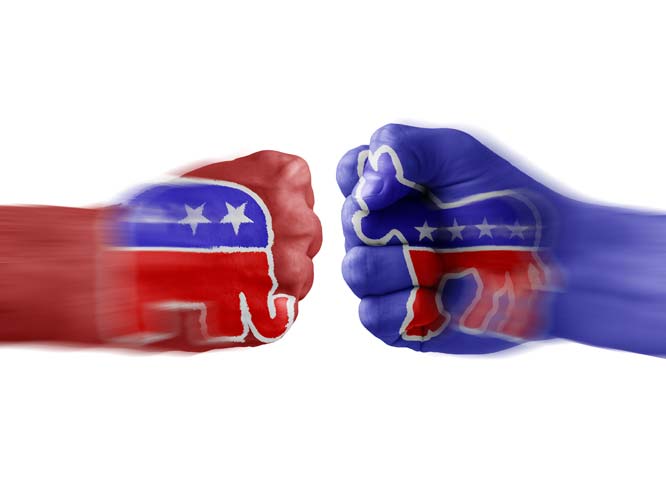
Both races could deliver a booster shot to nervous Republicans. Both can tell us how the parties are adjusting to a pandemic that has made traditional campaigning impossible.
"We've been keeping up with Democrats like we've never seen before," Mike Garcia, the Republican nominee in California's 25th Congressional District, said in an online interview Monday. "They're almost kind of writing off the election off at this point. This is the first domino in getting the House back."
Democrats have not written off the race, and were optimistic about the final days of ballot returns, which cut into the GOP's advantage. Still, neither of these races has captured national attention like the special elections that the parties poured resources into in 2017 and 2018. Neither attracted much interest from national political figures, either, who were locked down within days of the March 3 primary that set up today's California runoff.
The summer 2017 election in Georgia's 6th Congressional District absorbed $55 million of spending, from the candidates to the parties to outside PACs. In California, Garcia and Democratic nominee Christy Smith spent less than a tenth of that, according to mid-April filings; the two candidates in the Wisconsin race have spent less than $2 million.
Yet the districts perfectly represent some of the places where the rest of this election will be fought, from suburbs that have only recently moved toward Democrats, to rural areas that have raced away from the party.
In both races, the parties trying to hold the seats nominated candidates with winning electoral records, and the parties out of power nominated outsiders with compelling stories. The margins will matter, as Democrats see whether they've ebbed in places such as Palmdale and Santa Clarita, and Republicans see whether they've continued to make gains in the kinds of small Wisconsin towns that delivered big for President Donald Trump.
In California, the election was forced by the resignation of Katie Hill, one of the youngest women ever elected to Congress, seen by Democrats as a rising star. Hill had never run for office before 2018, then triumphed by nearly nine points over then-Rep. Steve Knight, as Smith narrowly won a seat in the California state assembly. One year later, operatives began publishing nude photos of the married congresswoman and a junior campaign staffer, and Hill quickly resigned, throwing her support behind Smith.
By that point, Garcia had been running for the better part of a year. He and Smith both earned spots in the May 12 runoff, pushing past Knight, who had launched an unsuccessful comeback attempt, and Cenk Uygur, the host of the left-wing video news network the Young Turks.
Even with the Democratic presidential primary driving turnout, and even as Democratic registration outpaced Republican registration in the district, Democratic candidates won barely more than 50 percent of the combined March 3 vote. And that was after Republicans snapped photos of a Democratic Congressional Campaign Committee meeting, which found the party's own polling capturing a very close race, a contrast with their public confidence.
The campaign that followed looked nothing like the 2018 race, when Hill benefited from the eagerness of Los Angeles Democrats to drive 30 minutes up the road and volunteer for her campaign. By Election Day, Smith claimed around 4,500 active volunteers, focused on making long-distance voter contacts and on getting people to turn in absentee ballots.
Garcia claimed between 400 and 600 volunteers, entirely from the district, all tasked with the same thing. Yet registered Republican voters returned their ballots at a higher rate than registered Democrats, coming into the final weekend with a eight-point lead, stronger than they'd run in 2018.
"It's a challenge," Smith admitted to Slate's Jeremy Stahl last week, saying the lack of in-person organizing had hurt Democrats. "As a candidate, you like that contact with voters, and generating of interest in town halls, and especially knocking on people's doors."
Garcia faced the same limitations but worked to make the race a choice between a political insider and a veteran who wanted to serve again. Republicans' negative messaging focused on two aspects of Smith's biography - she had served on the Newhall, California, school board when it issued layoff notices to teachers, and she led emergency preparedness committee in Sacramento but did not attend a hearing on covid-19.
Smith had dealt with the first charge in her 2018 legislative race, pointing out that the teachers were rehired, and worked to drown out the other charge by focusing on her real-time work to bring relief to the district.
At the same time, Smith worked to nationalize the race and tie Garcia to Trump. The Republican had given her material, browbeating Knight for having been occasionally critical of the president and telling interviewers that he would support Trump.
In late March, when Garcia spoke with The Washington Post, he said Trump had navigated "uncharted waters for any administration" and done a "good job," and then turned the conversation back to Smith. And Garcia benefited from voters' disappointment in Hill, who surprised everyone by using unspent PAC money to run an ad encouraging her supporters to turn out, even though she's grown unpopular in the district. (The ad was filmed in Washington.)
Democrats struggled to turn the race into a referendum on Trump. Their own polling, which modeled a Republican-leaning runoff electorate, found Trump's approval approximately even in the district in February, as his Senate impeachment trial wound down. Two months later, Trump was 10 points underwater in the district but Garcia's position hadn't budged - he was still in a single-digit race with Smith. And the race made national news only when Smith erred in an interview with the liberal group Indivisible, making fun of Garcia's frequent references to his military service by sarcastically asking, "Did you know he's a pilot?"
The president's own intervention in the race made Democrats much happier. He'd tweeted about the "pilot" gaffe, but weighed in at greater length after Democrats got the city of Lancaster to open a ballot drop-off location. The president tweeted that the votes from that site should "not count," even though the city's Republican mayor, who'd endorsed Garcia, had signed off on it. That gave Democrats their closing message: "Mike Garcia sides with Donald Trump 100%."
That pitch could backfire if Garcia wins, giving the president something he has lacked recently - an election win in which he played a notable role. But both sides are cautious about predicting when the race could be called. Garcia said in a Monday interview with the American Conservative Union that he'd have to win by a big margin to "account for any funny business coming out of the left," citing the new Lancaster polling place, and Democrats began closing the ballot-return gap in the race's final days. That's not unusual for California, where Democrats tend to do best with last-minute voters.
But a Republican win would test Democrats' confidence in their new theory of politics, breaking a 20-year streak of gains in California's suburbs and revealing how some of those areas might not be on board with the party yet.
There's less uncertainty in Wisconsin, where state Sen. Tom Tiffany has been the clear favorite to replace former Rep. Sean P. Duffy in the state's largest and most rural district. (Duffy retired early, citing health concerns with his youngest child, and later joined a lobbying firm.) Democrats nominated Tricia Zunker, a school board member in the district's biggest city, to fight for a seat they lost in the 2010 wave and had largely stopped competing in. Duffy's 2018 challenger has raised less than $125,000 for her race; Zunker has raised close to $500,000.
But Democrats, who used last month's statewide Supreme Court race to test their absentee ballot outreach program, are expecting a loss and watching mostly for the margin. The district, redrawn by Republicans nine years ago to shore up Duffy, has moved steadily to the right. Barack Obama carried it by eight points in his 2008 bid and lost it by three points in 2012. Hillary Clinton lost it by 21 points, and while no Democrat has fared that badly since, none has been able to carry it again. In that Supreme Court race, which Justice-elect Jill Karofsky won easily, she lost the 7th Congressional District by six points.
Zunker has run a do-no-harm campaign, with ads promising that she'll focus on "health care and jobs" while Tiffany would undo the Affordable Care Act. (Zunker's ads are among the first to tie that directly to covid-19, warning that people with preexisting conditions are "most at risk.") Tiffany's ads pitch him as the candidate who can "stand with President Trump to get people back to work," and earlier ads had argued that the president "needs proven reinforcements in Congress."
Heading into Tuesday, northwest Wisconsin looked like the Republican future, a rural area that has abandoned its old affection for Democrats. The California race looked like the Republican past: affordable exurbs where voters have left the party thanks to Trump. But Republicans could come out of both districts with wins, six months before they have to try to do it all over again, with the president himself on the ballot.
(COMMENT, BELOW)


 Contact The Editor
Contact The Editor
 Articles By This Author
Articles By This Author